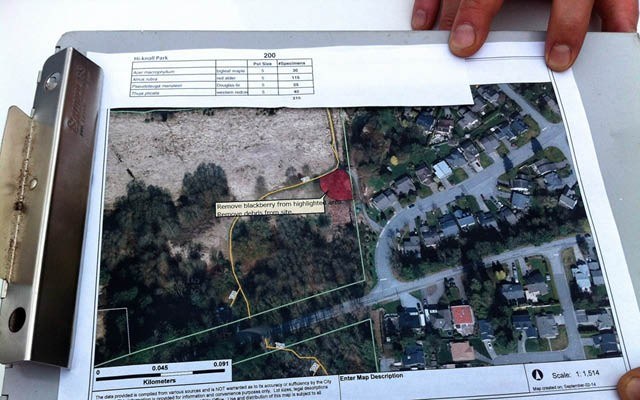It's spring, and a young man's fancy turns to... invasive plants. Like everyone else watching rubicund sprouts of knotweed push up through smitten soils and florescent sprays of bright-yellow Scotch broom lighting up roadsides, every spring sees me ponder anew how municipalities will cope with the scourge and who'll help in their efforts. Having spent years working on a book about invasive species, I've come to understand some of these partnerships.
A few years back I visited Fiona Steele, a professional biologist at Diamond Head Consulting, a specialized, multifaceted firm working to integrate environmental values into a range of projects and hoping, as its website touts, to "create great places that people will value for years to come." Lofty and poetic, yes, but a sincere ethos that leans heavily on collaboration, working with nature, and being both strategic and creative. With 14 years of forestry, ecology, and Geographic Information System (GIS) under her belt, Steele's passion for native plants led her into ecosystem restoration and urban invasive-plant management. She spent years working with municipalities to create policy and strategic plans for managing invasive plants that include inventories, habitat restoration, and co-ordinating large-scale control and removal programs. A past board member of the Invasive Species Council of Metro Vancouver, she currently sits on its Regional Invasive Species Strategy committee.
I'd call that a career, which I mentioned shortly after Steele and I sat down for coffee in a hip Vancouver industrial area. I also shared that I thought Diamond Head's touchy feely brand statement was a first for managing invasives — it almost sounded sexy.
"Most of my projects are still pretty mundane," she laughed. "We have a variety of clients but the big guys are Lower Mainland municipalities we do policy-development work with — everything from how crews will operate, to how to educate the public on what they're doing. We're also on the ground with invasive audits, removal, and restoration planting."
Specifically that means municipalities like Surrey, Burnaby, and North Vancouver, jurisdictions comprising enormous peri-urban and urban areas — with equally enormous invasive-plant problems.
"The District of North Vancouver (DNV) commissioned us to do a full inventory of invasives, then used it to develop an in-house strategy that it went full-steam ahead on," Steele related. "First thing they did was tackle all knotweed and hogweed on public lands — a brilliant move that gave them leverage to come down hard on private landowners."
While the DNV worked on a comprehensive invasives policy, the City of North Vancouver — DNV's urban core — was even further ahead on its own. Unfortunately, knotweed travels downstream through watersheds, and much of DNV sits above the city. Similar issues flared across the region; Surrey, for instance, did much on the invasives front while Metro Vancouver, accommodating tens of thousands of Surrey commuters daily, was, at the time, doing diddly-squat. "Vancouver is lucky their largest parks have active volunteer groups making measurable impact," said Steele. "Stanley Park's 'ivy busters' removed English ivy from every single affected tree in the park, and while the plant still grows there, the trees are all protected for now."
Steele's tales varied from disheartening, to uplifting, to just plain funny. "We inventoried knotweed on the City of Richmond's dike system because it was concerned that if it treated well-established knotweed, dead (root systems) might create air-pockets that could compromise the dike. So they contacted the government of Holland to see what it was doing about knotweed on its dikes, and the Dutch were like 'Oh... interesting — what are you doing about yours?'"
The municipality Diamond Head was most invested with, however, was Burnaby.
"Burnaby got on the invasive bandwagon early. In 2009 we conducted a city-wide inventory in natural areas for their parks department. It was a massive job, especially because we didn't have iPads or anything and did it all on paper. But it's the way for any jurisdiction to start because then it knows what it's facing — maybe an audit doesn't catch everything, but there's a sense of what the priorities are. The intention was to take the inventory information and create an invasive plant strategy, but Burnaby didn't do that right away — probably because full integration between departments on the idea hadn't happened yet. Their approach was a bit haphazard, but Parks was still able to follow up on some of our recommendations."
Within that followup, however, lay another hurdle: Burnaby's bylaw against cosmetic herbicides stood in the way of eradicating invasives. To nudge higher-ups to allow managers to use them when necessary, Parks contracted Diamond Head to attempt the physical removal of knotweed for three years — just to prove it didn't work.
One could sympathize with Burnaby's parks department. Working within governments on invasives always required prioritizing. What was an imminent problem? What did you have the capacity to work on? Who would help? Were there things you could do without the slow-motion parliament required for bigger plans?
Melinda Yong, Burnaby's environmental co-ordinator for Parks, Recreation, and Cultural Services, knew all too well the limitations alluded to by Steele, and would fill me in when I dropped by her office a few weeks later.
Next week: Invasive gestalt II: On the ground
Leslie Anthony is a Whistler-based author, editor, biologist and bon vivant who has never met a mountain he didn't like.




